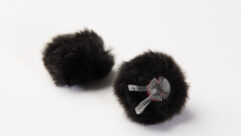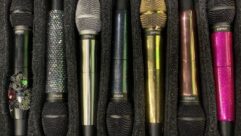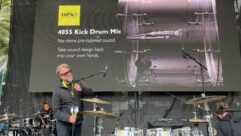
DPA Microphones 4066/4088
Nov 1, 2004 12:00 PM,
By John McJunkin
Accurate sound for high-SPL environments.
DPA Microphones has a tradition of making microphones that sound uncannily natural. Its designs are significantly different from those of other manufacturers, and while some may raise an eyebrow at some of the more unorthodox mechanisms they use, there’s no denying that its mics reproduce sound with a high degree of accuracy.
DPA 4088 cardioid headband microphone
Among the advancements achieved by DPA is the continual shrinking of microphones while maintaining high levels of quality. The 4063, for instance, is the size of a match head and provides truly excellent quality. The 4066 is a headband-mounted version of that mic, perfect for vocalists in a live setting or for broadcast applications. Since the 4066 is an omnidirectional microphone, feedback from stage monitors in a high-SPL environment is an issue. In order to help solve the problem, DPA has introduced the 4088, which is a cardioid mic with similar characteristics. We’re going to compare and contrast the 4088 and the 4066, and see which mic is better suited to your needs.
TECH SPECS
First, the technical specifications of the 4066. It’s .5in. in length and only .21in. in diameter. It weighs .5oz, including the cable and Microdot connector. Phantom power is required, and the 4066 is very forgiving with operational voltage ranging from 5V to 50V. DPA makes two protection grids available, each with significantly different acoustical characteristics. The “soft-boost grid” provides a soft bump of 3dB between 8kHz and 20kHz, and the “high-boost grid” yields a significant boost of 10dB at 12kHz. In both cases, the frequency range is from 20Hz to 20kHz ±2dB (with the obvious contour changes made by the grids). Sensitivity is nominally 6mV/Pa (±3dB at 1kHz). Equivalent noise is -28dB maximum (A-weighted).
The technical specifications of the 4088 are very similar to the 4066. It’s a bit more squat at .43in. in length and .25in. in diameter. It weights .5oz, including cable and Microdot connector. It operates on a range of phantom power from 5V to 50V. Frequency range is 20Hz to 20kHz ±2dB between 500Hz and 20kHz, with a soft boost of 4dB to 6dB at 15kHz. Sensitivity is nominally 6mV/Pa. The equivalent noise rating is -28dB maximum (A-weighted). Maximum SPL before clipping is 144dB. THD is less than 1 percent at peak SPL of 123dB. Output impedance ranges from 30V to 40V, and like the 4066, it’s available in black or beige.
Under optimal circumstances, with a seasoned professional wringing monitors and today’s powerful automated anti-feedback devices, an omnidirectional microphone can be a perfectly appropriate choice for a vocalist or a speaker. Nonetheless, a cardioid mic is still preferable due to its feedback-fighting directionality. In this case, the 4066 is already recognized by the industry as a microphone of very high quality. The remaining question is whether the sound quality of the cardioid version is sufficiently close to that of the omni. If so, choosing the cardioid for its feedback rejection is a no-brainer.
TEST DRIVE
I decided to put both mics to test in the 6,000-square-foot live sound venue at the Conservatory of Recording Arts & Sciences in Tempe, Ariz. DPA’s 4063 mic, among others in its line, is intended as an instrument microphone, but the 4066 and 4088 are pretty much exclusively used as vocal mics, and that was the paradigm for our comparison. The large venue at the Conservatory requires the instructor to be amplified, so we initially put the 4066 with the soft-boost grid on live sound instructor Keith Morris with absolutely no equalization. My immediate reaction was very positive. The sound coming from the JBL Vertec line array was a picture-perfect representation of Morris’ voice. There was essentially no coloration or exaggeration of particular frequencies. No big surprise. Moreover, Morris was able to stroll around the room with no feedback.
We then replaced the 4066 with the 4088. The presumption was that a cardioid mic would certainly not exhibit feedback problems in the same situation where its omnidirectional counterpart did not. Of course, this was indeed the case. As to the quality of the representation of the instructor’s voice, there was no appreciable difference between the omni and the cardioid. The 4088 provided the same accurate, uncolored representation of the voice as the 4066. For applications where feedback is a likely problem, the 4088 proves the better choice, providing the same high-quality representation with a significant reduction in the likelihood for feedback.
The natural tendency of audio engineers and performers alike is to locate the mic’s pickup directly in front of the performer’s mouth. DPA’s design is such that this placement is not only unnecessary, but incorrect. The capsule is intended to hover just to the side of the performer’s mouth. The design of the mic means no loss of any frequencies resulting from this placement. And the benefit from an aesthetic standpoint is that the beige version of the mic blends in with the performer’s face, making the mic much less visually obtrusive. There’s no giant round black windscreen smack in front of the performer’s mouth. A black-coated version of the mic is also available for applications where aesthetics are not a consideration.
The headband support for the mic is really the only attribute that was not received with absolute delight. It’s formed of light and slender surgical steel and wraps around the back of the performer’s head, with hoops on each end that go over the top of the performer’s ears. Our voice talent reported that is was a bit uncomfortable, but certainly no more so than similar products from other manufacturers.
AS GOOD AS IT GETS
DPA makes some incredibly good microphones, and the 4066 and 4088 are no exception. I would even go out on a limb and say that these are the best head-worn microphones I’ve ever heard. They both roll off below 100Hz, so they may not be the best choice for a bass vocalist, but for the rest of the world, this is about as good as it gets. The 4066 is an excellent choice for lower-SPL environments, but if you need the same high degree of quality in a higher-SPL application, the 4088 is the one you’ll want.
Jhon McJunkinis the principal of Avalon Audio Services in Phoenix and consults for both studios and live sound applications.
SPECIFICATIONS
4066
Directional characteristics Omnidirectional
Cartridge type Pre-polarized condenser element with vertical diaphragm
Principle of operation Pressure
Power supply 5V- 50V through DPA adapter
Frequency range Soft boost grid: 20Hz-20kHz ±2dB, 3dB soft boost at 8kHz-20kHz High boost grid: 20Hz-20kHz ±2dB, 10dB boost at 12kHz
Sensitivity Nominally 6mV/Pa (±3dB at 1kHz)
Equivalent noise level A-weighted Typically 26dB re. 20µPa (max. 28dB)
Equivalent noise level Typically 38dB (max. 40dB) ITU-R BS.468-4
Max. SPL 144dB SPL peak before clipping
Total harmonic distortion 123dB SPL peak, 120dB SPL RMS sine (<1% THD)
4088
Directional characteristics Cardioid
Cartridge type Pre-polarized condenser element with vertical diaphragm
Principle of operation Pressure gradient
Power supply 5V-50V through DPA adapter
Frequency range 20Hz-20kHz (±2dB between 500Hz-20 kHz; 4dB-6dB soft boost at 15kHz)
Sensitivity Nominally 6mV/Pa (±3dB at 1kHz)
Equivalent noise level A-weighted Typically 26dB re. 20µPa (max. 28dB)
Equivalent noise level Typically 38dB (max. 40dB) ITU-R BS. 468-4
Max. SPL 144dB SPL peak before clipping
Total Harmonic Distortion 123dB SPL peak, 120dB SPL RMS sine (<1% THD)
PRODUCT SUMMARY
Company: DPA Microphones; www.dpamicrophones.com
Product: 4066 and 4088 headbands
Pros: Highly accurate, superior feedback rejection.
Cons: Headband less than completely comfortable.
Applications: Live vocal performances.
Price: $625 MSRP









